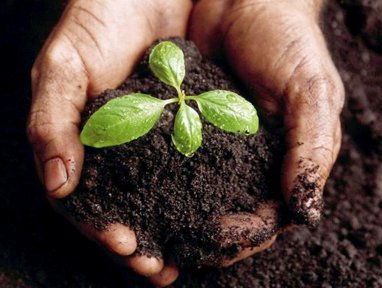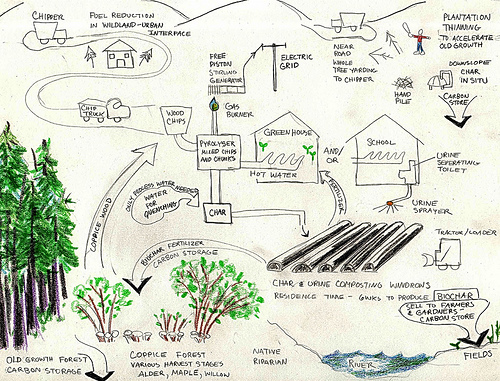Biochar: Difference between revisions
(inserted new section and research report) |
m (→Discussion) |
||
| Line 39: | Line 39: | ||
==Discussion== | ==Discussion== | ||
Could someone suggest a design for a simple flexi-pyrolysis unit that makes both charcoal and | Could someone suggest a design for a simple flexi-pyrolysis unit that makes both charcoal and syngas ? | ||
Some discussion of Biochar manufacture and use (including reference to mobile pyrolyser developed at VA Tech) on this blog posting: [http://turningpoints.iomaire.com/index.php/2009/06/13/biochar-make-it-or-buy-it/ Turning Points - Biochar: Make It or Buy It?]. | Some discussion of Biochar manufacture and use (including reference to mobile pyrolyser developed at VA Tech) on this blog posting: [http://turningpoints.iomaire.com/index.php/2009/06/13/biochar-make-it-or-buy-it/ Turning Points - Biochar: Make It or Buy It?]. Two [http://turningpoints.iomaire.com/index.php/2009/06/08/biochar-and-soil-fertility/ earlier] [http://turningpoints.iomaire.com/index.php/2009/06/12/what-is-biochar/ posts] on biochar from Turning Points blog. | ||
==Field Trial Results by BlueLeaf / Dynamotive (March 2011) == | ==Field Trial Results by BlueLeaf / Dynamotive (March 2011) == | ||
Revision as of 13:17, 11 March 2011
Main > Food and Agriculture > Soil and compost
According to the International Biochar Initiative: "Biochar is a fine-grained charcoal high in organic carbon and largely resistant to decomposition. It is produced from pyrolysis of plant and waste feedstocks. As a soil amendment, biochar creates a recalcitrant soil carbon pool that is carbon-negative, serving as a net withdrawal of atmospheric carbon dioxide stored in highly recalcitrant soil carbon stocks. The enhanced nutrient retention capacity of biochar-amended soil not only reduces the total fertilizer requirements but also the climate and environmental impact of croplands.
Char-amended soils have shown 50 - 80 percent reductions in nitrous oxide emissions and reduced runoff of phosphorus into surface waters and leaching of nitrogen into groundwater. As a soil amendment, biochar significantly increases the efficiency of and reduces the need for traditional chemical fertilizers, while greatly enhancing crop yields. Renewable oils and gases co-produced in the pyrolysis process can be used as fuel or fuel feedstocks. Biochar thus offers promise for its soil productivity and climate benefits."''
Some of the world's most productive soils (e.g. Canadian prairies, Russian Chernozem / or "black earth") are very rich in organic carbon, probably pyrogenic in origin and originating from prairie or forest fires. The black carbon is often thousands of years old, demonstrating its stability in soil. For more extensive background on Biochar, please look up the Wikipedia entry, read this background paper or consult the website of the International Biochar Initiative.
Uses of biochar in the ecology of products
- Inexpensive soil amelioration for degraded land
- Increased biomass productivity
- Efficient use of biomass waste for energy generation
- Reduced need for fertilizer input (e.g. manure), which is important for the planned Permaculture Plantout at Factor e Farm.
- Combine biochar with vermicompost to make superb fertilizer.
- Pyrolysis gas can be used for energy (i.e. compressed fuel gas) and as a heat source (e.g. for heating greenhouses). As a source of hydrogen, CO and small amounts of methane, pyrolysis gas may be useful for various processes
- Bio-oil and tars are also by-products of pyrolysis, can be turned into biodiesel
- Use Lifetrac (and soil pulverizer) to mix char into soil, till
- Add charcoal to compost heap to speed up composting (probably works via enhanced microbial activity)
- Biochar for sale as a source of income for an emerging community.
- Combine with solar thermal heat source to make an open source solar pyrolysis unit
- Charcoal is already needed for other purposes, e.g. metal smelting
- Charcoal as filter: can be used for water purification and filtration, later become biochar; can be used to filter pyrolysis gas itself
- Lastly, charcoal can also help neutralize smell in a composting toilet. Then it becomes biochar, ultimately.
How to make it
Instructable on the retort kiln: http://www.instructables.com/id/How-to-Make-some-Charcoal/
The Biochar Economy
(source)
Specifics
When large chunks of wood are used as feedstock, they may need to be crushed before use (beware: coal dust explosion !). Many agrigultural feedstocks and leaf litter will not need to be pulverized.
For information on small-scale gardening, please consult the Gardening with Biochar FAQ, an excellent resource.
Discussion
Could someone suggest a design for a simple flexi-pyrolysis unit that makes both charcoal and syngas ?
Some discussion of Biochar manufacture and use (including reference to mobile pyrolyser developed at VA Tech) on this blog posting: Turning Points - Biochar: Make It or Buy It?. Two earlier posts on biochar from Turning Points blog.
Field Trial Results by BlueLeaf / Dynamotive (March 2011)
"Biochar Commercial Agriculture Field Trial in Québec, Canada – Year Three: Effects of Biochar on Forage Plant Biomass Quantity, Quality and Milk Production" (Full details of the report available here)
These are the first biochar field trials undertaken in northerly latitudes (45° north).
Key results include:
- Continued greater biomass growth for the third consecutive year in biochar-amended soils
- Nutritional quality of plants grown in biochar-amended soil is verified by near infrared spectroscopy for first time
- Plant nutrient uptake efficiency and plant nutritional quality is greater in plants grown in biochar-amended soil
- This greater plant nutritional value leads to greater milk production from these forage plants
- In addition to the greater nutritional value of plants grown in biochar-amended soil as well as greater milk production, environmental advantages are anticipated through reduced leaching and reduced greenhouse gas emissions
- These results were achieved with a relatively low biochar application rate (3.9 t/ha), in a northerly climate (N45˚), on normal agricultural soils.
The results of these trials reinforce other research pointing to potentially important advantages for the use of biochar as an agricultural soil amendment, both for economic and environmental reasons.


